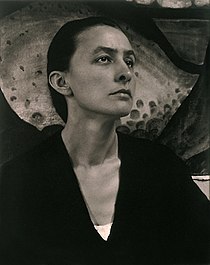Georgia O’Keeffe
| Georgia O'Keeffe | |
|---|---|

Georgia O'Keeffe, 1918, photograph by Alfred Stieglitz
|
|
| Born |
Georgia Totto O'Keeffe November 15, 1887 Town of Sun Prairie, Wisconsin, U.S. |
| Died | March 6, 1986 (aged 98) Santa Fe, New Mexico, U.S. |
| Nationality | American |
| Education |
School of the Art Institute of Chicago Columbia University University of Virginia Art Students League of New York |
| Known for | Painting |
| Movement | American modernism |
| Spouse(s) | Alfred Stieglitz (m. 1924; his death 1946) |
| Awards |
National Medal of Arts (1985) Presidential Medal of Freedom (1977) |
|
Whitney Museum of American Art |
|
|
|
 |
|
|
|
Georgia Totto O'Keeffe (November 15, 1887 – March 6, 1986) was an American artist. She was best known for her paintings of enlarged flowers, New York skyscrapers, and New Mexico landscapes. O'Keeffe has been recognized as the "Mother of American modernism".
In 1905, O'Keeffe began her serious formal art training at the School of the Art Institute of Chicago and then the Art Students League of New York, but she felt constrained by her lessons that focused on recreating or copying what was in nature. In 1908, unable to fund further education, she worked for two years as a commercial illustrator, and then spent seven years between 1911 and 1918 teaching in Virginia, Texas, and South Carolina. During that time, she studied art during the summers between 1912 and 1914 and was introduced to the principles and philosophies of Arthur Wesley Dow, who espoused created works of art based upon personal style, design, and interpretation of subjects, rather than trying to copy or represent them. This caused a major change in the way she felt about and approached art, as seen in the beginning stages of her watercolors from her studies at the University of Virginia and more dramatically in the charcoal drawings that she produced in 1915 that led to total abstraction. Alfred Stieglitz, an art dealer and photographer, held an exhibit of her works in 1916. Over the next couple of years, she taught and continued her studies at the Teachers College, Columbia University.
She moved to New York in 1918 at Stieglitz's request and began working seriously as an artist. They developed a professional relationship, he promoted and exhibited her works, and a personal relationship that led to their marriage in 1924. O'Keeffe created many forms of abstract art, including close-ups of flowers, like the Red Canna paintings, that many found to represent women's genitalia, although O'Keeffe consistently denied that intention. The reputation of the portrayal of women's sexuality was also fueled by explicit and sensuous photographs that Stieglitz had taken and exhibited of O'Keeffe.
...
Wikipedia
